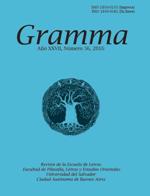Lucía Miranda (1860) of Eduarda Mansilla and its Italian Genealogies
Keywords:
Lucía Miranda, Eduarda Mansilla, Genealogies, Naples, Manzoni, De AngelisAbstract
Lucía Miranda (1860), the first novel by the Argentinian writer Eduarda Mansilla de García (1834-1992) keeps several genetic and genealogical secrets well hidden. The presence of a secondary plot that takes place in Naples (Italy) is a unique fact along all the remakes of the so called «Lucía Miranda’s episode» during centuries, from the chronicle by Ruy Díaz de Guzmán finished around 1612. There are «intratextual» reasons: Naples, presenting the quintessence of high Italian culture, has a strong symbolic value in the interaction Nature/Culture, Barbarism/ Civilization, America/Europe, Wilderness/City, as well as the feminine genealogy (María de las Rosas-Nina Barberini) that «places into abyss» the story of the main feminine character, Lucía Miranda. But there are also «intertextual» motivations for appealing to an Italian scene: the acknowledged, and recently found out debt of the author, Eduarda Mansilla, towards Alessandro Manzoni and his masterpiece: The Betrothed (I promessi sposi), to which she attributes the upheaval of her literary vocation. Finally, the fact of Naples being the chosen scenario, refers us to Eduarda Mansilla’s familiar relationship with don Pedro de Angelis: the great Neapolitan scholar, first editor and publisher of Ruy Díaz de Guzmán’s chronicle. Indeed, he put his best talents to serve her uncle, the Governor Juan Manuel de Rosas, but first of all, he used them at the service of the future historical Argentinian legacy.Downloads
Published
How to Cite
Issue
Section
License
Works published in this journal are licensed under a Creative Commons Attribution-NonCommercial-
Works published under this licence may be shared, copied and redistributed in any medium or format. Adaptation, remixing, transformation and creation are also authorised. Both sharing and adapting are permitted as long as credit is given to the work appropriately, providing a link to the licence and indicating whether changes have been made. Commercial use of the material is also not possible.








